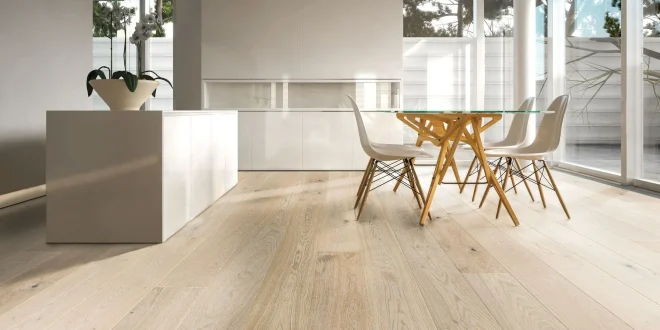Wooden flooring has long been one of the most sought-after flooring options, known for its timeless elegance, durability, and ability to enhance any space. Whether used in residential homes, offices, or commercial spaces, wooden floors add warmth, character, and value to a property. As trends evolve, wooden flooring continues to remain a popular choice due to its versatility and natural beauty.
In this article, we’ll explore the key aspects of wooden flooring, including the types available, the benefits of wood floors, maintenance tips, and what to consider when selecting the right wooden flooring for your space.
1. The Appeal of Wooden Flooring
Wooden flooring offers a unique charm that synthetic materials can rarely replicate. The natural grains, colors, and textures of wood create a sophisticated yet cozy environment, making it a top choice for many homeowners and designers.
A. Natural Beauty and Warmth
Wooden floors are prized for their natural beauty, with each plank featuring unique grains and tones. This natural variation adds depth and character to a room, creating a warm and welcoming atmosphere. Whether you prefer the rich, dark tones of walnut or the light, airy feel of oak, there’s a wood species to suit every taste and design style.
- Versatile design options: Wooden floors complement a wide variety of interior styles, from modern and minimalist to traditional and rustic. The versatility of wood makes it a great foundation for any decor.
- Aesthetic flexibility: Wooden flooring can be finished in numerous ways—stained, oiled, or painted—to match the desired look. Additionally, different plank widths, patterns, and finishes provide endless possibilities for customization.
B. Durability and Longevity
When properly maintained, wooden floors can last for generations. Unlike carpet or laminate, which may need to be replaced after a few years, high-quality wood flooring can be refinished multiple times to restore its beauty and extend its lifespan.
- Hardwood options: Hardwoods such as oak, maple, and hickory are extremely durable and resistant to wear, making them ideal for high-traffic areas in homes and commercial spaces.
- Sustainability: Many wooden flooring options are environmentally friendly, sourced from sustainably managed forests, making wood a renewable and eco-conscious flooring choice.
2. Types of Wooden Flooring
There are several types of wooden flooring available, each with its own unique characteristics and benefits. Understanding the different options will help you select the right flooring for your needs.
A. Solid Hardwood Flooring
Solid hardwood flooring is made from a single piece of wood, typically ¾ inch thick. This type of flooring can be sanded and refinished multiple times, making it a long-lasting and resilient choice.
- Long-term investment: Solid hardwood floors can last for decades, even up to 100 years with proper care, making them a great investment for any property.
- Moisture sensitivity: Solid hardwood is not recommended for areas with high humidity or moisture, such as bathrooms or basements, as it can warp or expand when exposed to moisture.
B. Engineered Wood Flooring
Engineered wood flooring consists of a top layer of real wood veneer, bonded to layers of plywood or high-density fiberboard. This construction makes engineered wood more stable than solid hardwood, especially in areas with fluctuating humidity levels.
- Greater stability: Engineered wood is less prone to warping and shrinking, making it suitable for basements, kitchens, and other areas where solid hardwood may not be ideal.
- Variety of finishes: Just like solid hardwood, engineered wood can be found in a range of finishes and styles, offering the same aesthetic appeal as traditional hardwood.
C. Parquet Flooring
Parquet flooring features small pieces of wood arranged in intricate patterns, such as herringbone or chevron. This type of flooring adds a touch of sophistication and artistry to any space.
- Design versatility: Parquet floors offer a range of design options, from classic herringbone patterns to more complex geometric designs. They are often used in formal spaces like dining rooms or entryways.
- Customizable: Parquet flooring can be made from a variety of wood species and finishes, allowing for further personalization.
3. Benefits of Wooden Flooring
In addition to its beauty and durability, wooden flooring offers a range of benefits that make it a popular choice for both residential and commercial spaces.
A. Easy to Clean and Maintain
One of the key advantages of wooden flooring is that it’s easy to clean and maintain. Dust, dirt, and allergens don’t get trapped in wood floors the way they do in carpet, making wood a more hygienic option for those with allergies.
- Low maintenance: Regular sweeping and occasional mopping are usually enough to keep wooden floors looking their best. For deeper cleaning, wood-safe cleaners can be used to restore shine and remove stubborn stains.
- Resistant to stains: Spills are easy to clean up on wooden floors, making them an ideal choice for dining areas, kitchens, and living rooms.
B. Long-Lasting Durability
Wooden floors are built to last. Solid hardwood can withstand decades of use, and even engineered wood is designed to handle high traffic. Over time, wooden floors develop a patina that adds to their charm, rather than detracting from it.
- Refinishing capability: One of the greatest benefits of wood flooring is its ability to be sanded down and refinished. This means that even after years of wear and tear, you can restore your floor to its original beauty.
- Scratch resistance: While wood floors can scratch, especially in high-traffic areas, finishes such as polyurethane can provide added protection.
C. Adds Value to Property
Installing wooden flooring is an investment that can significantly increase the value of your property. Homebuyers often look for hardwood flooring, viewing it as a premium feature due to its durability and timeless appeal.
- Desirable feature: Hardwood flooring is considered a high-end feature in real estate, often making homes more appealing to potential buyers.
- Increased resale value: Homes with wooden floors often sell faster and at higher prices than homes with other types of flooring, making it a smart choice for homeowners looking to enhance property value.
4. How to Choose the Right Wooden Flooring
When selecting wooden flooring, several factors should be considered to ensure that you choose the best option for your space and needs.
A. Room Usage and Traffic
Consider how much traffic the room will receive when choosing wooden flooring. High-traffic areas such as hallways, living rooms, and kitchens will benefit from harder, more durable wood species like oak or maple, while softer woods like pine may be better suited for bedrooms or low-traffic areas.
- High-traffic areas: Choose harder wood species or consider engineered wood for greater durability and moisture resistance.
- Low-traffic areas: Softer woods or parquet flooring may be suitable for more decorative, low-traffic spaces like formal dining rooms or offices.
B. Moisture and Humidity Levels
The moisture level in a room is an important consideration when choosing wooden flooring. Solid hardwood is best suited for rooms with stable humidity levels, while engineered wood or moisture-resistant finishes are better for areas like basements, kitchens, and bathrooms.
- Humidity considerations: Engineered wood is less likely to warp or expand in areas with high humidity, making it a better choice for moisture-prone rooms.
- Avoid water exposure: Wood floors should not be installed in areas where they will be exposed to standing water or excessive moisture.
C. Style and Aesthetic Preferences
Wood flooring comes in a wide range of styles, finishes, and colors. Consider the overall design of your home when choosing wood species, plank width, and finish.
- Wood species: Lighter woods like ash and maple create a modern, airy feel, while darker woods like walnut and mahogany add richness and warmth to a room.
- Plank width: Wide plank floors are popular in modern designs, while narrower planks and parquet patterns offer a more traditional look.
5. Conclusion
Wooden flooring is a timeless and elegant choice that offers beauty, durability, and value for any space. With a variety of wood species, finishes, and styles available, wooden floors can be customized to suit any aesthetic. Whether you choose solid hardwood, engineered wood, or parquet, wooden flooring will enhance the ambiance of your home or business while providing long-lasting performance. When selecting your flooring, consider factors such as room usage, humidity, and design preferences to find the perfect wood floor for your needs.
 Diverse Perspectives: Insights & Stories Exploring Ideas, Sharing Knowledge
Diverse Perspectives: Insights & Stories Exploring Ideas, Sharing Knowledge





